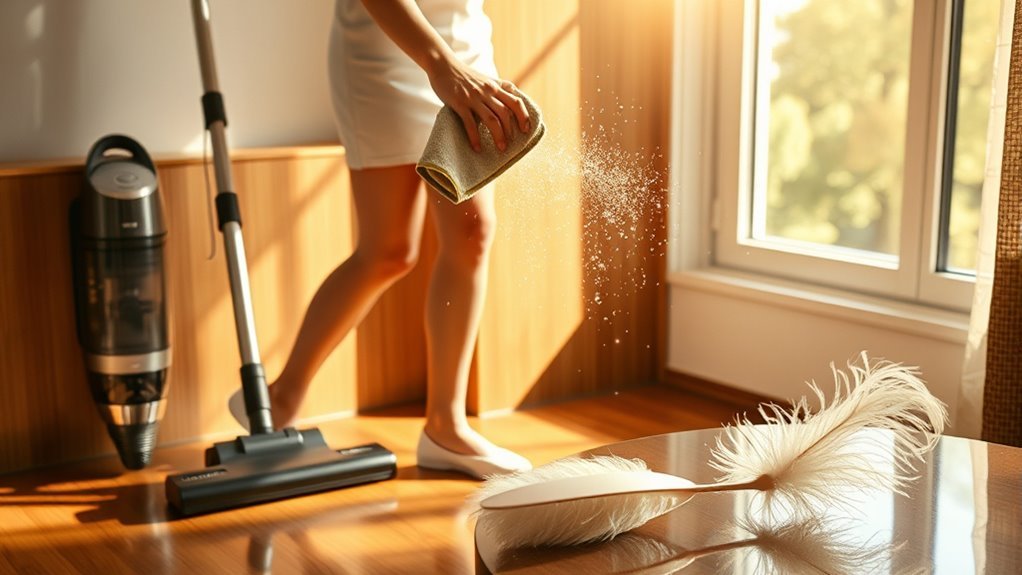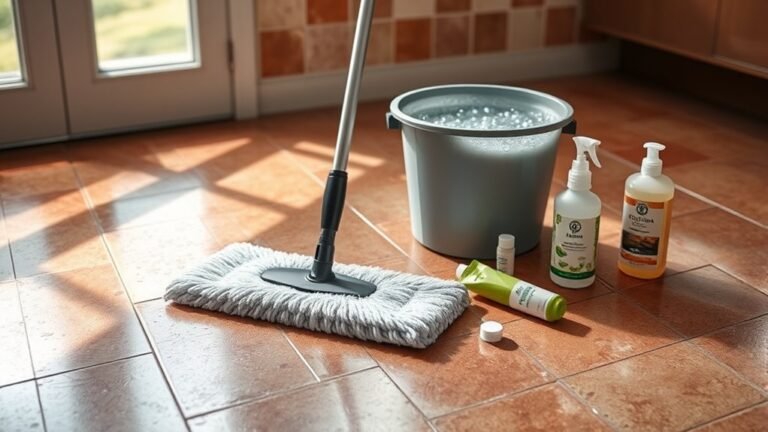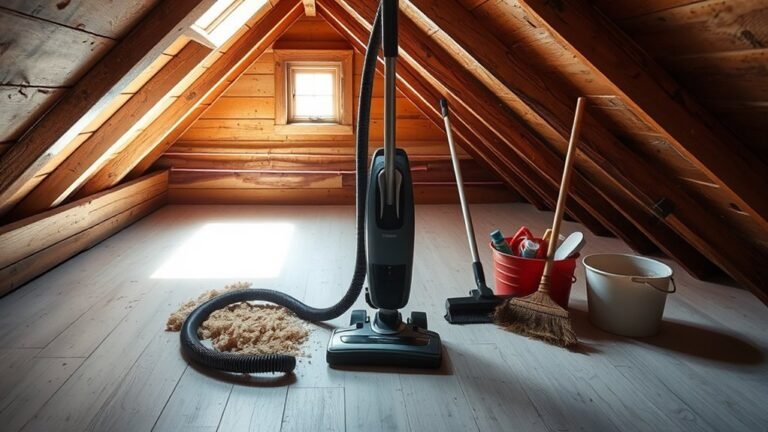Cleaning Techniques for Dust Owners
To manage dust effectively, start by using microfiber cloths and electrostatic dusters to trap particles, avoiding dust scattering. Vacuum upholstery gently with adjustable suction and clean floors regularly with mops or vacuums. Pay attention to high-traffic areas and use doormats to minimize dust entry. Keep air purifier filters fresh to improve air quality. Establish a consistent cleaning routine and consider natural sprays to repel dust. Explore these tips more, and you’ll find even better ways to keep your space fresh.
Understanding the Sources of Dust

Dust comes from many sources, and understanding where it originates can help you manage it better. When you know the dust particle origins, you gain control over your environment, enhancing your indoor air quality and your freedom to breathe easy. Dust isn’t just dirt; it includes skin cells, fabric fibers, pollen, and even microscopic particles from outside. These particles settle on surfaces, making your space feel cluttered and affecting your health. By recognizing that dust comes from both inside and outside your home, you can take steps to limit its entry and accumulation. This awareness empowers you to create a cleaner, freer living space where you’re not held back by sneezing or allergies caused by poor indoor air quality.
Selecting the Right Cleaning Tools
To tackle dust effectively, you’ll need the right tools at hand. From microfiber cloths to specialized dusters, each has its role in capturing particles. Plus, choosing the right vacuum type can make a big difference in keeping your space dust-free.
Essential Dusting Tools
Choosing the right tools can make all the difference when it comes to keeping your home dust-free. To master effective dusting techniques, you’ll want to equip yourself with essential supplies that work for every surface. Microfiber cloths are a must—they trap dust instead of pushing it around, giving you a cleaner finish with less effort. Extendable dusters help you reach high or tricky spots without climbing or stretching, saving time and strain. Don’t forget an electrostatic duster; it attracts dust particles magnetically, making quick work of shelves and electronics. By selecting these essential dusting tools, you gain control over your environment and free yourself from the hassle of dust buildup, helping you enjoy a fresher, lighter living space effortlessly every day.
Choosing Vacuum Types
While having the right dusting tools is essential, selecting the proper vacuum cleaner can greatly enhance your cleaning routine. If you want freedom from constant hassle, consider robotic vacuums—they work on their own, letting you relax. Upright vacuums offer powerful suction and often come with multiple vacuum attachments, perfect for carpets. Canister vacuums provide versatility, easily handling tight spaces and various surfaces. Handheld vacuums are great for quick cleanups and small areas. Decide between bagged vacuums, which trap dust more securely, or bagless vacuums with cyclonic technology that maintain suction without bags. Pay attention to vacuum filters to reduce allergens, and check noise levels to keep your cleaning peaceful. Choosing the right type means you’ll enjoy a dust-free space with less effort.
Effective Dusting Techniques for Surfaces

Although dusting might seem straightforward, using the right techniques can make a big difference in how clean your surfaces stay. You want to match your dusting techniques to the surface materials to avoid damage and maximize effectiveness. For delicate surfaces, use a microfiber cloth to trap dust without scratching. Hard surfaces like wood benefit from slightly damp cloths, preventing dust from scattering.
| Surface Material | Recommended Dusting Technique |
|---|---|
| Wood | Slightly damp microfiber cloth |
| Glass | Dry microfiber cloth or static cloth |
| Delicate items | Soft, dry microfiber cloth |
How to Clean Upholstery and Fabrics
When it comes to cleaning upholstery and fabrics, vacuuming regularly can keep dust and dirt at bay. You’ll also want to know the best stain removal methods to tackle spills quickly. Finally, using fabric protection strategies helps maintain your furniture’s look and extends its life.
Vacuuming Tips
Vacuuming upholstery and fabrics effectively requires a few key steps to guarantee you remove dust without damaging the material. Mastering vacuuming techniques lets you enjoy a cleaner space while preserving your freedom from constant worry about wear. To get started:
- Use a vacuum with adjustable suction to avoid pulling threads.
- Attach a soft brush tool for gentle yet thorough dust removal.
- Vacuum in multiple directions to lift trapped dust from fibers.
- Empty vacuum bags or clean filters regularly as part of vacuum maintenance tips, ensuring consistent power.
- Check for and clear blockages to maintain suction strength.
Stain Removal Methods
After you’ve mastered vacuuming to keep dust at bay, handling stains on upholstery and fabrics becomes the next challenge. Different stain types—like grease, ink, or wine—need specific removal products to work effectively. First, identify the stain to choose the right product, whether it’s a mild detergent for organic stains or a solvent-based cleaner for tougher spots. Always test removal products on a hidden fabric area to avoid damage. Blot stains gently without rubbing to prevent spreading. For fresh stains, act quickly; for set-in stains, you might need repeated treatments. By understanding stain types and using the correct removal products, you’ll maintain your upholstery’s freedom from stubborn marks, keeping your space fresh and dust-free without hassle.
Fabric Protection Strategies
Protecting your upholstery and fabrics from stains and wear starts with choosing the right cleaning and maintenance techniques. When it comes to fabric care, staying proactive can save you time and money while keeping your space fresh. Here’s how you can take control:
- Regularly vacuum to remove dust and prevent buildup.
- Use protective sprays designed for your fabric type to repel stains and spills.
- Immediately blot spills instead of rubbing to avoid spreading.
- Rotate cushions and pillows to guarantee even wear.
- Schedule deep cleaning sessions every few months to maintain fabric integrity.
Managing Dust in Hard-to-Reach Areas
When dust settles in tight corners or high shelves, it can be tricky to remove without the right tools and approach. You want to break free from stubborn dust traps that limit your clean space. Here are smart cleaning hacks to help you reach every nook with ease and keep your freedom intact.
| Tool | Best For | Cleaning Hack |
|---|---|---|
| Extendable Duster | High shelves | Use with microfiber head |
| Compressed Air Can | Electronics, vents | Blow dust out, not spread it |
| Vacuum with Hose | Tight corners | Attach narrow nozzle for reach |
| Sticky Tack Roller | Small crevices | Lift dust without damage |
Use these tools confidently to reclaim your space from hidden dust!
Tips for Maintaining Dust-Free Floors

Now that you’ve tackled dust in those hard-to-reach spots, it’s time to focus on your floors—the biggest surface area where dust tends to gather. Effective floor maintenance is key to dust prevention and keeping your space feeling fresh and open. Here are some simple tips to help you maintain dust-free floors:
- Vacuum or sweep regularly, especially in high-traffic areas.
- Use a microfiber mop to trap dust instead of just pushing it around.
- Place doormats at entrances to reduce dirt and dust tracked inside.
- Avoid clutter on floors to make cleaning easier and more thorough.
- Consider removing shoes indoors to minimize dust buildup.
Using Air Purifiers to Reduce Dust
Although regular cleaning helps reduce dust, using an air purifier can greatly improve the air quality in your home. Air purifiers trap airborne dust particles, allergens, and pollutants, giving you fresher, cleaner air to breathe. One of the biggest air purifier benefits is the freedom from constant sneezing, coughing, or irritation caused by dust buildup. To keep your purifier working efficiently, don’t forget filter maintenance—regularly check and replace filters as recommended. Neglecting this step limits its effectiveness and can even worsen air quality. By integrating an air purifier into your space, you’re not just cleaning—you’re reclaiming control over your environment, allowing you to enjoy a healthier, dust-reduced lifestyle without feeling trapped by constant dust concerns.
Establishing a Regular Cleaning Schedule
A consistent cleaning schedule is key to keeping dust under control and maintaining a healthier home environment. You don’t have to follow a rigid routine; schedule flexibility lets you tailor cleaning frequency to fit your lifestyle. Here’s how to establish a practical routine without feeling trapped:
- Identify high-traffic areas needing more frequent dusting.
- Set realistic cleaning days that suit your weekly flow.
- Use reminders or apps to keep your schedule on track.
- Combine tasks like vacuuming and wiping surfaces for efficiency.
- Adjust your routine seasonally to match dust levels.
Natural Remedies for Dust Control
Since chemical cleaners can sometimes cause irritation or environmental concerns, you might want to try natural remedies for dust control. Homemade sprays made from simple ingredients like water, vinegar, and a few drops of essential oils offer a safe and effective alternative. Lavender, eucalyptus, and tea tree oils not only add a pleasant scent but also help repel dust particles. You can spritz these sprays on surfaces before wiping to trap dust without harsh chemicals. Plus, creating your own cleaning solutions gives you the freedom to customize scents and avoid unnecessary additives. Embracing these natural methods helps maintain a cleaner space while respecting your health and the planet. With just a bit of effort, you’ll enjoy a dust-free home that aligns with your values and lifestyle.
Frequently Asked Questions
Can Pets Increase Indoor Dust Levels?
Yes, pets can increase indoor dust levels because they shed pet dander, which adds to the dust in your home. If you’re sensitive, pet dander can be one of the main allergy triggers, making it harder for you to breathe freely. You don’t have to give up your furry friend, but staying on top of cleaning and ventilation can help keep your space comfortable and dust under control, so you can enjoy your freedom.
How Does Humidity Affect Dust Accumulation?
You might think keeping humidity low is just about comfort, but it actually helps control dust accumulation. When humidity levels rise, dust mites thrive because they love moist environments. These tiny pests latch onto your freedom from allergies and clean air. By managing humidity, you reduce dust mites and prevent dust from clinging to surfaces. So, controlling humidity isn’t a chore—it’s a simple step toward a fresher, freer living space.
Are Certain Types of Flooring Better for Dust Control?
If you want to control dust better, hardwood flooring offers great benefits since it doesn’t trap dust like carpets do. Carpet drawbacks include holding onto dust, allergens, and pet dander, making cleaning tougher and limiting your freedom to breathe easy. With hardwood, you can quickly sweep or mop, keeping your space cleaner and more open. So, choosing hardwood helps you enjoy a dust-free environment with less hassle.
What Role Do Plants Play in Reducing Dust?
You might not expect nature to battle dust, but air purifying plants do just that—they’re living dust absorbing species that actively clean your space. While dust seems relentless, these green allies work quietly, improving air quality and trapping particles. By welcoming them into your home, you’re not just adding beauty but embracing freedom from constant dust buildup. It’s a simple, natural way to breathe easier and feel more liberated indoors.
How Often Should HVAC Filters Be Replaced to Reduce Dust?
You should stick to a regular replacement schedule for your HVAC filters to keep dust at bay. Typically, changing filters every 1 to 3 months works best, but it depends on your environment and filter type. Staying on top of filter maintenance not only improves air quality but also gives you the freedom to enjoy a cleaner home without constant dust buildup. Don’t let neglect slow you down—make it part of your routine!






